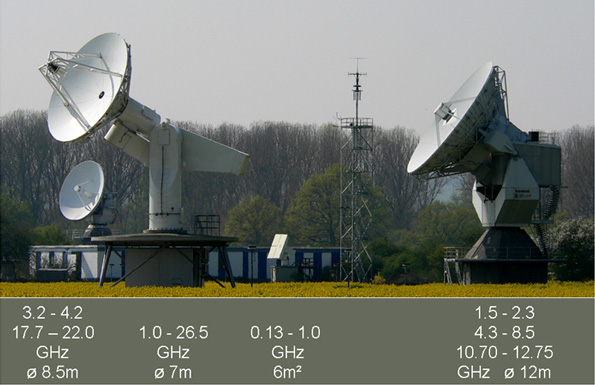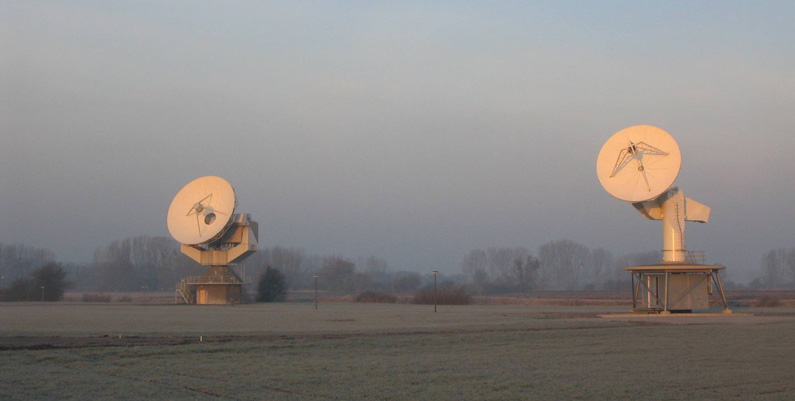Space radio monitoring station Leeheim
The Bundesnetzagentur's space radio monitoring station is located near the Rhine in Leeheim, about 35 kilometres south-west of Frankfurt/Main. The station's full-motion parabolic antennas with diameters of up to 12 metres are directed at satellites in space. The antennas are not designed for commercial radio communication but form the heart of the station's facilities used to monitor the spectrum allocated to space services and investigate interference to space services using the spectrum.
The number of satellites in orbit is increasing and so also is the need for satellite spectrum, making forward-looking planning for spectrum use increasingly important. The risk of interference is also increasing. Having the technology to identify causes of interference quickly is extremely important in economic terms for both operators and users.

Leeheim: alle Antennen
The Bundesnetzagentur's station in Leeheim monitors space services within the framework of national legislation and international agreements. Its range of tasks includes locating and eliminating radio interference to satellite communications.
Roles of the space radio monitoring station
Aid in planning and coordinating satellite systems
General orbit monitoring helps to determine actual use of the spectrum by space services, transponder occupancy, and occupancy of the geostationary orbit by satellites.
Special spectrum occupancy measurements, in conjunction with spectrum coordination for instance, help to identify potential interference early on when satellite systems are being planned.
Tool for positioning and operating satellites
Telemetry and telecommand spectrum monitoring before geostationary satellites are launched helps to ensure that satellites are successfully positioned.
Satellite transponder occupancy measurements ensure that satellite systems are operated as published, coordinated and notified at international level.
Dealing with cases of interference involves identifying sources that would otherwise continue to interfere with the operation of satellite and terrestrial services.
Detecting sources of uplink interference
Cases of uplink (Earth-to-space) interference, where interference is caused to and not by a satellite, are becoming more frequent. There has been a rapid increase in the number of earth stations (such as VSATs – very small aperture terminals) since users have been allowed direct access to satellites. Earth stations are the main source of uplink interference, which can be caused by technical or operational faults. There have also been cases of unauthorised use of satellite transponders as well as intentional interference to transponders. This is a challenge for authorities, operators and users.
Leeheim monitoring station is equipped to identify the geographic position of the source of uplink interference and thus resolve the interference without needing detailed information about the interfering signal. The system locates sources of interference by measuring the time difference of arrival (TDOA) and the frequency difference of arrival (FDOA) of the interfering signals received at Leeheim via the interfered satellite and an adjacent satellite. Interference can normally be eliminated quickly as soon as the source is located.
The system is designed for the 1,5 - 1,8 GHz, 2,1 - 2,3 GHz, 3,2 - 4,2 GHz, 7,25 - 7,75 GHz, 10,7 - 12,75 GHz und 18,3 - 22,0 GHz bands.
Supporting compatibility studies
Spectrum allocated to space services is usually also used for terrestrial services. Leeheim monitoring station supports theoretical compatibility studies with in situ tests with the aim of enabling shared use of the spectrum by space and terrestrial services. The monitoring station also assists with measurements when new satellite applications are being introduced.
Antennas 1 and 4
Antenna 1 (on the left in the photo) is a 12-metre parabolic antenna and is essentially a broadband antenna for the 1-13 GHz band. Special feed systems with optimised characteristics at 1.5-1.8 GHz, 2.1-2.3 GHz and 10.7-12.75 GHz and high positioning accuracy are required for monopulse tracking for high-precision antenna pointing. A rotatable reflector and a feed positioner allow switching between the different bands.

Leeheim: Antennen 1 und 4
Monopulse tracking is not possible in the relatively wide band 4.3-8.5 GHz covered by antenna 1. However, all of the antennas have computer-controlled position tracking in all bands.
The high mechanical angle velocity for the azimuth and elevation axes means that the antennas can also track any non-geostationary satellite.
Antenna 4 (on the right in the photo) is a 7-metre parabolic antenna; its special XY axis geometry makes it especially suitable to track non-geostationary satellites despite its slow rotation speeds. The antenna covers the whole of the 1-26.5 GHz band with eight switchable feed systems.
Measurement parameters
- frequency
- Doppler shift
- class of emission and type of modulation
- bandwidth
- polarisation
- total power flux-density
- power flux-density in a reference band
- equivalent isotropically radiated power (eirp).
The station can also determine the orbital elements of space objects, for instance to identify unknown satellites in the event of interference.
The services of the space radio monitoring station in Leeheim are also available to other European countries under the terms of a memorandum of understanding. Further information about this memorandum of understanding can be found on the European Communication Office (ECO) website: Satellite Monitoring MoU
Contact
Bundesnetzagentur
Section Eschborn
Space Monitoring
64560 Riedstadt-Leeheim
Germany
Phone: +49(0)6158 940-0
E-Mail: Esch16.Postfach@BNetzA.de